
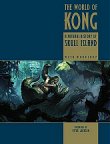
Note: This essay is a tribute
to the book, “World of Kong: A Natural History of Skull Island” by Weta
Workshop, published 2005 by Pocket Books, which in turn is based upon and
derived from both the original King Kong and Son of Kong movies of the
1930s, and upon Peter Jackson’s King Kong remake of 2005. Each
is an extraordinary work in and of itself. This essay is devoted
to exploring and extending certain of the ideas contained in these remarkable
works.

“Giant stone ruins of this
ancient society dotted the entire island. Vast edifices jutted from
the shrouding jungle and tumbled down the coat to disappear into the sea.
Beneath the tangled forest that enveloped the island in a choking green
embrace, a great city had once breathed.” (Page 18)
King Kong’s Skull Island is home to a vanished civilization
now known only by a series of megalithic ruins. Who were these
people? Where did they come from? How did they live?
“Study of these remains
and of the great wall itself - which had run in an unbroken circle around
the entire center portion of the island - told of a culture three thousand
years old. Architectural parallels suggested Southeast Asia as a
homeland.” (Page 18)
Unfortunately, most of these questions cannot be answered
with any certainty. Instead, we can only look to the information
that we have before us to see what we can make of it.
First, the Skull Island people were not indigenous to
Skull Island. Well, that’s sort of a no-brainer. In one
sense, Aborigines are not indigenous to Australia, Maori not indigenous
to New Zealand, etc. etc.. Everyone originally came from somewhere
else. The world was largely explored and settled by hunter
gatherer tribes.
Skull Island is certainly not any kind of candidate for
birthplace of the human race. The zoological fauna of Skull
Island includes almost no mammals, and certainly no higher primates or
apes. It is dominated by survivals from the Jurassic and Cretaceous,
and by species who have essentially ‘rafted’ in. It was never
a place originally settled by hominids.
Indeed, the current aboriginal population of Skull Island
survives only by sitting behind a protective wall. So its unlikely
that any hunter/gatherer culture could have made it to Skull Island and
establish itself.
Whatever the original Skull Island society was, they were
certainly not hunter/gatherers. Indeed, the evidence is that they
were quite advanced when they reached the Island. There are
various clues.
For one thing, they seem to have imported at least two
other major species with them: The bovine Gaur or oxen:
“A most curious member
of the Skull Island menagerie, and a regular on the menu for Venatosaurus,
was a species of tall cattle called Gaur. Quite obviously a recent
arrival, Skull Island’s Gaur was almost identical to a mainland Asiatic
species, suggesting that it may have been imported to the island some time
in the last thousand years or so by a previous civilization originating
on the continent. The logical assumption would be that this same
civilization built the great wall and the many ruins scattered through
the forest of Skull Island.” (Page 134)
As well as the giant apes themselves:
“The origin of Kong’s species
is as obscure as Skull Island itself, but what seems certain is that his
kind arrived no earlier than a few thousand years ago and were not native
to the island. Ape effigy bearing ruins abounded, supporting
the theory of Kong’s kin being revered by the ancient people of the land.
Perhaps the apes were also bred by them? Perhaps they were brought
with the ancient colonists from some lost empire in Asia....
(Pages 212-213)
The oxen were clearly a domesticated species, the apes possibly
so. Neither of these animals, even as juveniles, was going to be
carried on an extended ocean voyage in a simple dugout canoe.
We can assume therefore, that the water craft of the Skull Island people
was probably quite large. They were sophisticated boatbuilders who
built large and carried large and delicate cargo.
Domesticated oxen also tell us something about them.
They were not hunter gatherers, obviously. Domesticated oxen
tell us that they practiced agriculture, which also implies crops and other
domesticated plant and animal species. It tells us that they
used animal power to enhance their manpower, that their ‘animal-powered’
agriculture probably supported a reasonably high level of technology, population
and social organization.
In short, these were not idle travelers, but rather, at
the outset, before they ever got to Skull Island, they were an advanced
and quite sophisticated people, with some real accomplishments.
“It was theorized that
ancient colonists brought with them an established culture, as evidenced
by the great carved statues and shards of magnificent pottery left behind.”
(Page 18)
And, they had some connection to Kong. How do
we know this? Two reasons. There is the recurring
motif of the great apes in the art and decoration of the Skull Island civilization.
Ape faces occur frequently, where human or animal faces do not. Clearly,
the apes had some major totemic significance to these people.
Given this level of significance, it is likely that there is a connection
between the humans and apes, two anomalous species on the island.
“They were a devoted culture
who revered the giant apes that abounded throughout their art. Some
have speculated that the apes may have arrived with the colonists, alluding
to a symbiosis between the people and the ancestors of Kong.”
(Page 18)
Then there is the fact that Kong and his race were biological
anomalies on Skull Island, there were no other giant mammals, no other
advanced primates, and there was simply no evolutionary history or context
to support the Kongs being there naturally. They obviously
couldn’t swim, they were too big to raft, so they had to have been brought
over. Since the oxen were also likely brought over, it seems
reasonable to assume that the Kongs were part of the package.
This tells us that, in all likelihood, Kongs or giant
apes were a well established or entrenched part of the Skull Island Culture
before they got to Skull Island.
And here is where our problems start. There
is no historical or archeological or palentological record whatsoever of
giant apes anywhere near the scale of the Kong species.
There is a palentological record of a giant ape called
Gigantopithecus. But Gigantopithecus, by the absolute best estimates
stood no taller than 10 feet and weighed in at 1500 pounds, and many estimates
have him smaller and lighter. The Kongs weighed in at
least 18 to 25 feet, and an absolute minimum of 10,000 pounds or five tons.
They may have stood 50 feet erect and weighed in as much as 60,000 pounds.
Even assuming that the Kongs were bred upwards for size,
their forebears probably were not smaller than 5000 pounds, which simply
put them orders of magnitude beyond Gigantopithecus.
In any event, not only is there no record of Kongs on
the mainland, but there is no record of any known human culture associating
with giant apes, either Kongs or Gigantopithecus. Certainly
the skeletons of the giant apes are so remarkable, and the ape-iconography
of the culture is so distinctive it would be impossible to miss.
So, what we are dealing with here, is an advanced but
completely unknown human civilization of unknown provenance.
Who were these people, where did they get those apes? Why isn’t there
any record of them and their apes?
The problem is that Asia is not terra incognita.
In the estimated time period of Skull Island Culture, three thousand years
ago there were several organized, ancient and literate cultures, from the
Persians and Arabs, to the Hindu, the Burmese, Siamese, Khmer, Malay, Chinese
and Japanese in Asia which knew their coasts pretty thoroughly.
There is simply no room anywhere on the Asian mainland for such an Ape
oriented culture to exist, and certainly, if they had been active on the
mainland, their neighbors would have recorded them, and their cities would
have been known.
This is a fairly sophisticated culture, remember, with
agriculture, domesticated animals and fairly advanced technology in terms
of sea travel and monument or wall building. They can’t just
spring up overnight or out of nowhere.
So, where are they?
The only explanation that makes sense might be that they’re
the people of Mu.
Let me back this up a bit. Atlantis is a real
myth, in the sense that Plato wrote about it thousands of years ago, and
there is all sort of legendry and folklore, at least since then, alleging
its existence.
Lemuria is not a real myth. Lemuria was a sort of
19th century invention that was created to account for various anomalies
in the Indian Ocean. Related peoples and related species of plants
and animals, particularly lemurs and primates, which were found in widely
scattered island locations. People of that age found it puzzling
that clearly related species should be found so far apart. They didn’t
have a good grasp of evolutionary theory, and they had no idea about moving
tectonic plates. Instead, back then, there was a lot of talk
about land bridges and sunken or risen lands. So, scientists
speculated that there had been a continent or land mass in the Indian Ocean
which had connected all these islands and habitats, allowing the related
species to wind up in different places. They called this hypothetical
continent Lemuria.
Of course, there was never any such place. Better
understanding of geology, of plate tectonics, and of the evolution of species
and their distributions made it both unnecessary and impossible.
However, before any of that happened, the mystics got
ahold of it. Theosophists, Prophets, and Occultists all decided
that Atlantis was nice, but it was sort of old hat. Lemuria, shortened
to Mu was a blank slate that they could inscribe their fantasies on.
There was a nice symmetry to it. Atlantis was a sunken continent
in the Atlantic, attributed as the source of Western civilizations.
Lemuria or Mu was a sunken continent in the Indian Ocean. Mu
could also be a sunken continent in the Pacific, if you weren’t too clear
on geography. The result was some hair raising lunatic stuff.
Well, none of that here, okay. We ain’t going there.
We’re not getting into any mystical twaddle. As far as Lemuria
goes, well, the homeland of Lemurs is Madagascar.
But still and all, those giant apes have to come from
somewhere, and that’s nowhere in the known territories. And
still and all, the Skull Island progenitors had to come from somewhere,
and that somewhere had to have been big enough to support a healthy population
of humans and giant apes, and to have been there long enough for a real
fairly sophisticated civilization to have emerged. And once
again, that’s nowhere in the known territories.
So, we might as well call it Mu, for want of a better
name.
Ergo: The Giant Apes have to come from somewhere
else, call that place Mu1. And the Skull Island Progenitors
have to come from somewhere else, call that place Mu2.
So, we have two potential somewhere elses which cross over with each other
at some point, or we have one very remarkable somewhere else, Mu.
Wherever or whatever this somewhere else was, it ain’t around any more.
And, having given it a name, let us proceed to describe
its properties. Mu or Mu2 has to have been either an Island
or a coastal land mass. Why? Because the
Muans were sailors, they made it to Skull Island. This tells us that
they weren’t stuck all the way in some interior. They had to have
access to the sea.
Mu or Mu1 had to be large enough to support a breeding
population of giant apes. So it must have been of fairly hefty
size. At least as large as Sri Lanka which supports a viable
population of elephants. Mu2 also sported a fairly sophisticated
civilization, which suggests a decent population, and therefore a healthy
bit of territory to support that population.
Mu or Mu1 is probably an Island rather than a peninsula
or piece of continent. Otherwise, there would be no room for the
apes to evolve to their elephant-like size. The fact that they
were able to get so big suggests that there was no competition and no predators.
So, definitely an Island. But Mu1 as an Island can’t be too far off
the main lands. Obviously, apes, and probably birds, monkeys and
some other critters were able to raft over.
So, Mu1 produces the giant apes, and eventually humans
of Mu2 come along and incorporate them into their culture.
Now, its possible that these humans were starting out
on another mystery island or continental land area, developed a civilization,
discovered Mu1 and Skull Island. In which case, we can infer
a second lost and isolated Island, now sunk or vanished, which would be
Mu2.
Or its possible, perhaps more likely, that humans who
were relatively low tech discovered Mu1. These could have been relatives
of the boat travelers who colonized Indonesia thousands of years ago.
They settled there, found and domesticated the giant apes and formed a
civilization which eventually made it to skull Island. In which
case, Mu1 and Mu2 are the same, its all Mu.
Personally, symmetry suggests we go with the one island
rather than two island theory. For one thing, it gets tricky
finding a place to put big islands. For another, basically, I don’t
want to have to sink more islands than we have to. After all, Skull
Island is sinking, the Mu of the apes has to sink, and the Mu of the Skull
island progenitors has to sink.
Thus, I’m going to assume that Mu was simply inhabited
by giant apes, settled by humans who then built the Mu civilization there,
and proceeded to Skull Island.
So, assuming this is the case, where do we go from here?
Well, there’s a bit of a riddle. It’s likely that the original settlers
of Mu were not carrying cattle with them. If we compare them
with other navigating cultures of the time, we can see that the original
settlers of Australia probably carried dogs with them. The polynesian
seafarers weren’t traveling with anything larger than goats and chickens.
The Vikings brought cows and oxen to Greenland and Iceland, but their ships
were huge compared to those who settled Indonesia, Australia and the South
Pacific.
So, we can assume that the Mu culture did not acquire
oxen until it was a relatively sophisticated seafaring culture.
They probably picked it up from trade with mainland cultures and incorporated
it into their economy on Mu, carrying it with them to Skull Island.
Which begs the question: Did they have any
domesticated animals before they started sailing big time?
Well, its possible that they had food animals, small birds, perhaps larger
birds, perhaps even the burglar monkeys, using the biological stock available
on the island.
And then there were the Giant Apes. Now, it
may be a remarkable assertion to suggest that the Giant Apes were domesticated,
but its not necessarily unreasonable. Remember that the Apes,
going by the ruins on Skull Island, were a central part of the culture,
appearing repeatedly in effigies. The other thing to remember
is that the Skull Island ruins are megalithic in scale, and they’re widespread.
This isn’t just a lousy pyramid or temple. The entire centre
of the island was girdled with a massive, near continuous wall, some fifty
feet high and solid enough to have endured for thousands of years.
Building that wall is a colossal amount of hard labour, especially if you’re
limited to human labour. With beasts of burden, the task is
a bit more approachable.
In human history, several large animals have been domesticated
as beasts of burden: Dogs, Goats, Oxen, Camels, Llamas, Reindeer,
Horses and Asian Elephants. The Asian elephants are on the
scale of the giant apes, and might well have been far more versatile and
adaptable for tasks.
Certain factors seem to accompany domesticated animals.
Generally, they’re smaller than their wild counterparts, they have more
juvenile features as if domestication selects for a sort of arrested adolescence.
Of course, this isn’t a uniform rule - there are breeds of domesticated
dog far larger and more ferocious than their wolf forbears.
For some reason, domesticated breeds seem more tolerant
around humans and other animals, they seem more docile and patient, less
inclined to panic. For obvious reasons, domesticated animals tend
not to compete with humans for their needs - thus, they usually have diets
that humans cannot eat, and usually do not favour human diets. Thus,
both the domesticated animal and the human co-exist in the same environment,
dining off different parts of it.
Domesticated animals are invariably social species of
one sort or another, but not every social animal is domesticateable.
Except possibly for one north African strain made famous by Hannibal, but
now extinct, the African elephants cannot be domesticated.
Wolves are not domesticated, no matter how they resemble dogs. Meanwhile,
the North American Caribou is all but identical to the reindeer, but refuses
to be domesticated. You can raise wolves among dogs and caribou among
reindeer, but these creatures still have a basic wild and unpredictable
nature.
Rather, it seems that certain animals have a twitch in
their social structure, or perhaps some inbuilt placidity, that allows
them to enter into symbiotic or domesticated relationships with humans.
It also seems that this ‘twitch’ is fairly idiosyncratic, a near identical
related species, like a wolf, zebra or caribou may not share it.
So, looking to the primates, we can say safely that just
about every modern ape and monkey is social or potentially social.
On the other hand, not one of the extant ape species - Orangutangs, Chimpanzees,
Bonobos, or Gorillas have ever been domesticated, and likely they can’t
be.
Or can they be? There are fairly good reasons
why apes were never domesticated. For one thing, they’re mostly
hothouse species. They require highly specialized diets, they’re
often fruit eaters, preferring many of the same foods as humans.
Their preferred habitat is the jungles and rain forests. They
reproduce slowly and grow up slowly.
Compare this with say, cows or horses, who can feed wherever
there’s grass and who do not compete directly for foot, who reproduce quickly,
and whose offspring are fully grown and useable in only a couple of years,
and who exist in a wide variety of environments from grasslands to hill
country to brush where their talents are easily put to use.
Even dogs have versatile diets as scraps and scavengers, eating meat and
fish that do not meet human standards, they can exist anywhere, reproduce
in litters and grow rapidly.
So, in terms of opportunities posed, for the most part,
most of the human cultures were domesticating animals elsewhere.
There was little interest in domesticating gorillas or chimps in the environments
in which they were found. And in these environments, it was
generally easier to import beasts of burden.
Besides which, Apes although popular in human terms, probably
weren’t very useful for many human tasks. Can we imagine a knuckle
walking chimpanzee or bonobo carrying heavy loads? A gorilla pulling
a plow?
On the other hand, on Mu, there was a real incentive to
domesticate the giant apes. There was no other easily domesticatable
animal around. Moreover, the giant apes, like elephants, were
big enough and powerful enough that they could be employed in a useful
variety of tasks like oxen or elephants. And the environment
in which the Mu people lived was the same habitat as supported the apes.
It’s likely that the apes diets were distinct enough that the Muans could
be comfortable with such creatures. The only shortcoming would
be that the Giant Apes reproduced and grew slowly.
Of course, their abilities while domesticated, made up
for a lot of shortcomings. An elephant sized gorilla could
pull a plow, haul a wagon or sled, it could pull down trees, harvest fruit,
catch fish, drag nets or anything else any other domesticated animal could.
It could help to ferry boats in and out of harbours, and load boats.
It could help to build huge megalithic constructions, lifting and dragging
immense blocks. It’s mass/horsepower ratio, or its food/horsepower
ratio might be poor compared to other smaller and more efficient beasts
of burden. But, it was for much of Muan history, the only game in
town.
Probably the closest equivalent of the Giant Apes were
the Asian Elephants. These creatures were very large, very long lived,
somewhat specialized. So we might assume very similar situations
with the Giant Apes. Like the Asian Elephant drivers, the trade
of Ape Handlers was probably highly specialized. Ape masters
were probably a very respected caste, perhaps hereditary. They probably
formed long term relationships with individual apes, the way Hindu Elephant
Mahouts form long term working relationships with their Elephants.
They would be essential to many aspects of the economy
of the Mu people, and so its likely that both the Apes and their handlers
would be considered a special caste, venerated and adored, and the Apes
would sit very high in the art and iconography of Mu.
The Oxen, when imported, proved much more efficient in
many different ways. Their limitations of intelligence and ability
were overcome by their coarser diet, higher horsepower ratio and faster
reproduction. No specialized skills were needed to handle oxen, and
you didn’t necessarily need a long term, carefully nurtured relationship.
But by this time, we can see the giant apes were thoroughly entrenched
in Muan society. The iconography of the Skull Island ruins
continually venerates the Apes, but has nothing much to say to the lowly
ox.
Of course, if we want to be provocative, we might turn
things on its head. Perhaps the apes were the Muan civilization,
and it was humans who were the junior partners. Insane?
Perhaps. But Gorillas and Chimps can handle limited language and
approach childlike levels of reasoning with a cranial capacity of only
600 cubic centimeters, compared to the humans 2000. Even allowing
for a smaller proportional area, an ape the size of an elephant would have
a cranial capacity as great as or far greater than human. Elephants
brains are four times the size of humans. Of course, human
brains have extensive folding for cognition and thought, while apes and
elephants are fairly smooth. Not only do we have big brains, but
we do a lot with them. But this doesn’t rule out the possibility
of giant apes brains approaching or exceeding human volumes and complexities.
So, conceivably, the Mu civilization, and the Skull Island settlement was
created by the Apes. It puts a slightly different complexion
on Kong.
Is it likely? I dunno. Its possible.
But it strikes me as unlikely that the isolated apes of Mu would have the
need to develop technology, would have the geographical and temporal range
to develop culture and society. Human cultures have advanced
because they cover so much ground. When you’ve got humans through
Europe, Asia and Africa, that’s a lot of creatures in a lot of environments
having to cope and having ideas. When a good idea occurs anywhere,
it will spread all the way.
The Kong Apes were confined to a single relatively small
island, with a stable hospitable environment. So its hard to
see them as innovators and civilization builders, no matter how smart they
might have been. In particular, its hard to see them coincidentally
building their own ape civilization at the same time that another civilization
building species, humans, are just coincidentally wandering in.
So no, the Muans were a human civilization.
The Giant Apes might have been intelligent enough to be partners of some
sort, but its not their civilization. They’re just another
domesticated species, unique, remarkable, perhaps even semi-participants.
But that’s about it.
But we’re now getting a slightly better window into the
Mu Culture. They were a people inhabiting a tropical island
and using domesticated giant apes for trade, war, transportation and agriculture.
With the aid of such apes, they mastered megalithic construction techniques.
They were likely fishers, using boats to harvest fish around their shores.
Their developing technology and social organization allowed them to build
bigger and more ambitious monuments, and eventually, bigger and more ambitious
seagoing boats.
So, inevitably, the Muans embarked on their age of exploration.
How did it go? Well, we know they reached the asian mainland,
and acquired oxen. Well, we know they reached Skull Island,
established a colony and transplanted giant apes and oxen.
But that seems a thin record.
The Muans clearly did not reach Australia, or if they
did, they found it too inhospitable to establish a colony.
They did not reach Madagascar, which was a fertile unoccupied land that
was not occupied by humans until thousands of years later. And certainly,
if they left no traces on Madagascar, they never made it to Africa.
They did not reach Mauritius or Reunion, and so those Islands remained
uninhabited, and their unique species of dodos remained unmolested until
Europeans arrived. They didn’t reach the Seychelles or Maldives,
which remained uninhabited, nor Kerguelen or Crozet.
So, at best, their age of exploration took them to the
Asian coasts, perhaps as far east as India and Sri Lanka, perhaps as far
west as Indochina . They likely made it to Java and Sumatra
and some of the other Indonesian Islands.
But except for Skull Island, they made almost no impression.
Why not?
Well, perhaps we’re being a little harsh on them.
The Muan culture may well have had influences in Indonesia or India or
Indochina, and may well have founded colonies or satellite societies which
are a part of our records. They may be an undocumented source
culture.
Or the Muans may have met relatively sophisticated cultures
or locals who were able to repel them. Founding colonies can
be a tough and difficult business, especially if the locals object.
Certainly by this time, agriculture and animal domestication were established,
the mainland cultures were using the ox and it was a very efficient animal.
The Muans simply didn’t have the technological or numerical edges to enforce
their dominion. Nor is colonization an automatic option.
Many societies, from the Phoenicians to the Dutch and Portugese, preferred
to trade rather than establish colonies, preferred commerce to empire building.
Of course, these cultures are inevitably trashed by the empire builders.
And the Muans may have found themselves handicapped.
Their Giant Apes were terrific assets. But they probably didn’t travel
well, they were likely extremely vulnerable to mainland diseases (for reasons
discussed elsewhere), they reproduced slowly, so each loss was very difficult
to replace. Their technological and biological toolkit may not have
supported much expansion against other humans.
Its possible that there was some impact. One can
imagine remarkable battles as armoured apes and their mahouts clashed with
elephant cavalry. Perhaps the apes gave rise to lore of giants and
monsters, of wild hairy men of surpassing strength and savagery whose legends,
and perhaps wandering individuals, made it as far as Europe.
Instead of conquering the mainland, or even Indonesia’s
Islands, the Muans went to the ‘low hanging fruit’ and colonized the only
major Island uninhabited by humans that they could find. Pity
for them it was Skull Island. If they’d only kept sailing and
made it to Madagascar or more genial parts of Australia, their history
might be very different. But instead, it was Skull Island.
It’s quite possible that hunter/gatherer tribes, traveling
in small dugouts had made it to Skull Island before the Muans. Indeed,
it may have been that the same diaspora that settled Mu also reached Skull
Island.
But the fauna of Skull Island was quite aggressive and
more than a match for poorly equipped aboriginals. The Megafauna
of this Island had spent millions of years savagely polishing their teeth
on each other and were rather more able to cope than the Megafauna of lands
such as Australia or Madagascar.
But, the Muan civilization was different.
They had their own kick ass Megafauna in the form of their giant apes and
their oxen. They had weapons technology beyond that of the hunter
gatherers, and complex social organizations that allowed them to field
entire armies. They were willing to take on Skull Island on
its own terms.
And they did at least half well. Its pretty
clear that the Skull Island megafauna were neither intimidated nor threatened.
The Muans had to build a gigantic, Island spanning wall to hide behind.
Clearly, what they did was pick a relatively temperate highland not heavily
trod by Dinosaurs, established control of the territory, and eventually
built a wall to secure themselves from the areas of heavy dinosaur population,
like the jungles.
The Muans may have attempted to domesticate some of the
life they found there, perhaps with some degree of success.
If so, all traces of such domestication are probably long lost.
On the other hand, its clear that the Muans introduced at least two species
to Skull Island, and its entirely possible that they may have introduced
other species as well, perhaps birds. These species either became
quickly extinct, or went feral.
So, what happened to the Muans? Well,
obviously, their island sank.
“The exact nature of the extinction that befell these
people remains a mystery. At least a thousand years ago they were
wiped out, leaving little behind but stowaway rats and the stone skeletons
of their city on a doomed island.”
It’s likely that the Muan Island was heir to the same
instability that afflicted Skull Island. But even before they
sank, its likely that their culture could have been in trouble.
Contact with the mainland was not an unreserved blessing. They might
have acquired new draft animals, new technology and trade good. But
they also probably were afflicted with new diseases for which they had
no defenses.
The people of Mu and Skull Island probably suffered periodic
plagues. And if one or more of these plagues struck at the
wrong time.... Concurrently with famines or droughts or earthquakes,
it would be very hard for their culture to recover. Certainly
plagues from the mainland might well have decimated the giant apes, which
would be another blow to the overall culture.
There may have been other factors. Civil wars,
failed wars against the mainland, population explosions and collapse, environmental
depletion and deterioration. Their civilization was probably
hit by continuing one-two punches that left them unable to adequately cope
with the troubles facing them. As their Island sank beneath
the waves, they found that they lacked the ability to save themselves.
Frankly, the fact that the Muans put so much effort into
establishing a colony on a place like Skull Island suggests that the main
culture on the Island of Mu was already experiencing considerable stress,
either from overpopulation or resource depletion or internal wars.
No one goes to a place like Skull Island to live, if things are all right
at home.
As to the final decline and fall of the Mu culture, and
their disappearance beneath the waves, we can only speculate as to what
happened and how. We can only guess at their problems, and the desperate
struggle they must have had.
The Skull Island colony was left on its own.
Or perhaps its decline and fall was simultaneous with its parent.
There was enough of Skull Island to allow us to at least guess as to what
must have happened.
Some mainland derived plague hit and decimated both the
human and the ape population. Or perhaps a famine hit.
Simultaneously with that, when the population was most vulnerable, Earthquakes
and Island subsidence destroyed crucial infrastructure including roads,
buildings, crops or irrigation, while bringing down large sections of the
wall. Reeling, and without sufficient arms or giant apes to
defend it, the Skull Island colonists could only beg for rescue and assistance
from a homeland that may no longer have existed, or which was struggling
with its own problems. The ruling reptiles resumed their throne
and the Skull Island society experienced a catastrophic collapse from which
there could be no recovery.
Did they vanish completely?
I don’t think so.
There was still a human population on Skull Island as
late as the twentieth century. Western explorers refused to
believe that forlorn village of savages had anything to do with the magnificent
ruins. But this posed the question of who the current inhabitants
were and were they came from.
“The first sight to greet
explorers of Skull Island was the mighty wall that divided humanity’s meager
settlement from the terrors of the jungle interior. Huge and imposing,
this enormous structure dwarfed the puny village huddling in its protective
shadow. This was not the work of that struggling populace, but the
legacy of some older, far more advanced civilization, long gone.”
Well, let’s get serious here. We have a culture
with no obvious or apparent relatives in any of the nearby islands.
This suggests that the date from a wave of colonization well before the
current inhabitants of the Indonesian and Indochinese regions. Since
the periods of these colonizations are well known, we can estimate reliably
at the very least how old they have to be. They may be much older
than that.
“The exact origin of the
natives was unknown. Their physiology did not closely match that
of any of the region’s inhabitants, and their myths hinted at a possible
stranding, so it is conceivable they came from very far away.”
Their folklore suggests that they were blown to the Island
by a storm. But this is hardly an answer. They would have had
to have been blown from some adjacent area. If they were blown
a great distance, then its likely that their technology was far more sophisticated,
their boats much larger, in order to allow them to survive the trip.
Either way, their originating culture is unknown, so wherever their source,
it must have been well before the cultures around the Indian Ocean established
themselves.
Meanwhile, the current Skull Island villagers have at
least one strange affinity with the ancient Skull Island culture.
They worship or venerate the giant ape, Kong.
“The roots of this tradition
were difficult to trace...”
Considering the remarkable and ferocious Megafauna that dominates
the island, the ape worship seems like a peculiar thing. In
Kong’s case, he must travel far beyond his habitual range in order to receive
his tributes.
So let’s be blunt here. The current village
of Skull Islanders, as degenerate and desperate as they may be, are clearly
the last relics of the Muan Civilisation which domesticated the Giant Apes,
and colonized Skull Island.

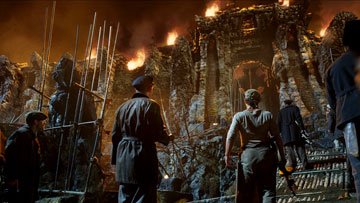

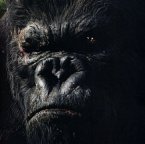
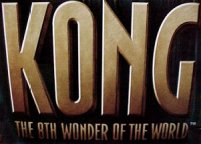
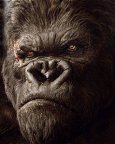
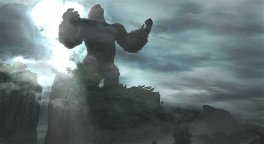
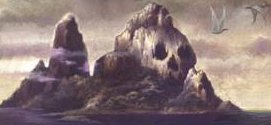

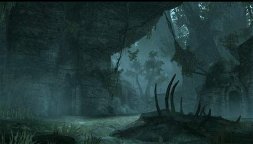









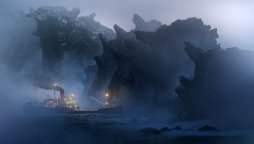
![]()

![]()
![]()

![]()